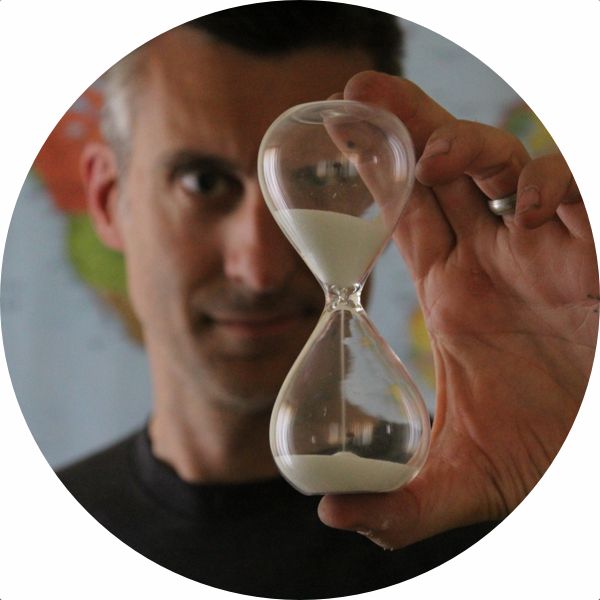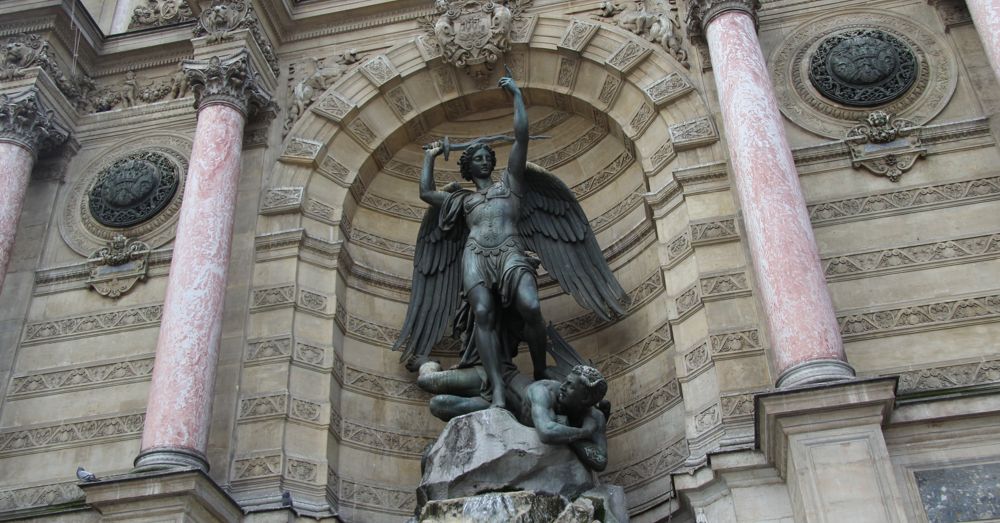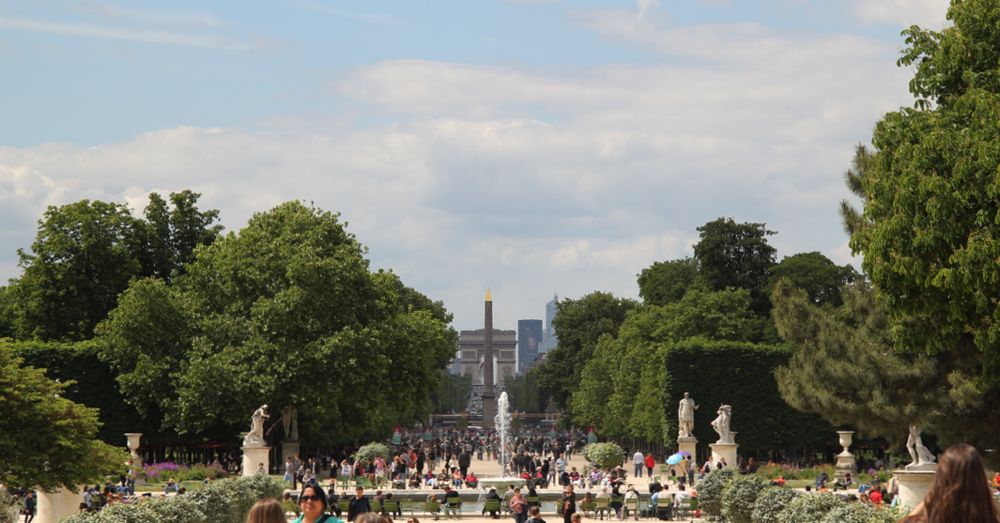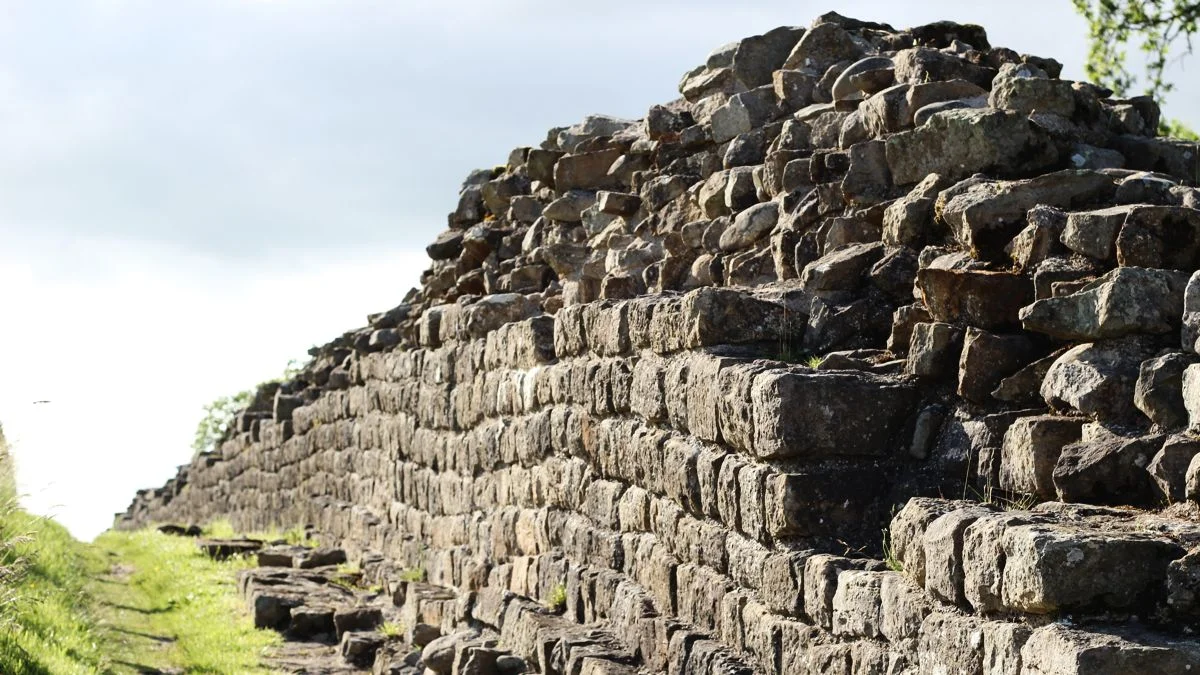Thursday, 21-05-2015. Day 274.
Assassinations, Emperors, Love Locks
As soon as we can when we enter a new city, we like to head over to where the Sandeman’s New Europe Free Walking Tour kicks off — and Paris was no exception. We got up early and took the Paris metro down to Place Saint-Michel, where we met up with Alberto, our guide from Mexico who would spend the next three hours giving us a tour of Paris in English.
St. Michael at his Place in Paris
I’m not going to keep you in suspense here — Alberto was a fantastic guide. One of the other guides called in sick, so he took the whole huge group (our biggest Sandeman’s tour yet) on his tour.
We spent a little time hanging out near Place Saint-Michel, and, after a brief explanation of what the nearby Latin Quarter was (a place of learning, not of ethnic derivation), we learned about the early history of Paris, from its roots as the home of the Gaelic tribe of fishermen known as the Parisii who lived on the two islands in the Siene — Île de la Cité and Île Saint-Louis.
The Parisii fished from the Seine and existed happily until the Romans came and did what the Romans did best — killed a lot of people, took their land, enslaved the survivors, and started building on the strategic location.
Because of the rich history of the area around these two islands, it is a UNESCO World Heritage Site — Paris, Banks of the Seine. After hearing about the city’s humble origins, Alberto led us off to Notre Dame Cathedral.
Notre Dame De Paris
The history of one of the most famous churches — and one of the best-known examples of Gothic architecture — in the world dates back to 1160 when the Bishop of Paris had the previous cathedral demolished (along with a few houses) and decreed that a new, grander cathedral would be built on the site. It was eventually completed in 1345. it, too, is a UNESCO World Heritage Site — Reims Cathedral (Notre Dame). Two in one day!
Notre Dame Cathedral
After the French Revolution (the late 1790s), Notre Dame was desecrated and fell into disrepair. The people felt it was representative of the evils of the monarchy — it is where the Pope crowned the Kings of France, after all — and the statues were destroyed and defaced (some were even beheaded).
Eventually, this great example of Gothic architecture was reduced to a place for storing food. And it might have been destroyed, if not for French author Victor Hugo.
Hugo loved Notre Dame. so much so that he wrote Notre Dame de Paris, (better known to English speakers as The Hunchback of Notre Dame) to save it. The book was published in 1831 and when people read Hugo’s words praising the majesty of the cathedral, it started a movement to restore it to its former glory.
This restoration work started in 1845 and lasted for 25 years. The church was again damaged during World War II, but restoration work, which continues today, have restored it to its former majestic state, albeit with modern conveniences (like LED lights).
While we didn’t go inside Notre Dame on the tour (although the four of us would do this later), Alberto did tell us all the story of Napoleon’s coronation as Emperor of France in 1804. Normally during the coronation ceremony the sitting Pope would crown the new ruler of France, but Napoleon, after wresting the crown out of the hands of a shocked Pope Pius VIII, crowned himself during the coronation.
Kilometre Zero
Kilometre Zero is a significant marker in front of Notre Dame — this is the spot from where all roads in Paris are measured.
All Parisian roads start here.
Alberto didn’t point out Kilometre Zero during the tour, but being a nut for such things, I knew it was there. I had just enough time to check it out before we walked the short distance to learn about the history of Pont Neuf.
Pont Neuf
Toothpullers Bridge (The New Bridge)
Even by 1550, Paris traffic was terrible, so to alleviate the busy Pont Notre-Dame, in 1577 Henry III commissioned a new bridge (called the New Bridge) to connect the banks of the Seine to Île de la Cité.
Even though construction started almost immediately, it wasn't completed until 1607 under the reign of Henry IV. Before long, it too was congested with traffic and was a haven for street performers, pamphleteers, sellers of trinkets, thieves, pickpockets, cutthroats — and toothpullers.
Toothpullers Bridge
Dental hygiene in 17th century France was not great. If you needed a tooth pulled, you came to the New Bridge. Alberto described the process — which used alcohol, a nail, and a hammer — in painful detail. As you might expect, it was a bloody process. As a result, the bridge was a bloody mess.
Good King Henry IV
The bridge is also known as the location of the statue of Henry IV of France, one of the most loved kings France has ever had. The statue in place today is a replica, but the first was erected in 1818.
King Henry IV
Although Henry was a Protestant, he converted to Catholicism in 1593 to end religious turmoil and keep peace in France, and it was this conversion that got him killed. While most people loved Good King Henry, some Protestants saw Henry as a traitor and some Catholics saw him as a pretender.
François Ravaillac was one of the Catholics who didn’t feel Henry's conversion was genuine and set out to kill him. And he succeeded, managing to assassinate Henry in 1610, mostly by luck. He was caught immediately and tortured to give up the names his co-conspirators. Despite being subjected to numerous tortures, he would give up only one name — that of God himself.
The people were so angry with Ravaillac for murdering their beloved king that death was too good for him. So after being tortured, he was scalded with molten lead and burning oil before being drawn and quartered. But even that wasn’t good enough, so the crowd took his body and they ate him — so his soul would be trapped in purgatory forever.
Love Locks
Alberto also told us the story of the Love Locks of Paris. We’ve seen these a few times in our travels, but didn’t know the history of them until Alberto gave us the backstory.
The habit of sealing your love to a fixed structure with a padlock is an old Serbian custom made famous by an Italian novel (Ho Voglia di Te [I Want You] by Federico Moccia), and immortalized in the final episode of Sex and the City.
Love Locks on the New Bridge in Paris. The Pont des Arts (the old lock bridge) is in the background.
Because of that episode, so many people were locking their love (80 tons worth!) to the Pont des Arts, a humble footbridge over the Seine, that it was breaking. On our visit, people were no longer allowed to lock their love on that bridge. So instead, enterprising lovers the world over started placing locks here at the statue of Henry IV, a vantage point from which you can see the Pont des Arts, making the New Bridge the New Lock Bridge.
Note: Starting 1 June 2015, the locks are being cut from the bridge (only a few days after our visit to Paris). So much for eternity.
The Louvre
From Pont Neuf we walked to The Louvre, possibly the world’s most famous museum and (probably?) the largest.
The Louvre
The Louvre began as a military stronghold, then transitioned to Royal Residences under Charles V (the Wise) and then to the headquarters for the post-Revolution France. From here, starting with Napoleon’s vast collection of Egyptian art, it slowly transitioned into the largest museum in the world with 37,000 works of art on display and more than 100,000 archived in the basement.
Its most famous piece of work is, of course, the Mona Lisa. This was brought to Paris by Leonardo da Vinci himself, a good friend (a real good friend, according to Alberto) of King Francis I, also known as Francis the Nose (on account of his large nose). It’s not famous for being a great work of art; instead it’s famous for being famous.
The Mona Lisa was stolen on 21 August 1911 (and it took three days for anyone to notice). It was stolen by an employee of the Louvre, an Italian who felt that this important piece of Italian art should be on display in Italy. Eventually (in 1913) it was returned to the Louvre, but not before none other than Pablo Picasso fell under suspicion for the theft. This act is what brought notoriety to the painting.
Modern pyramids, Renaissance buildings in Napoleon Courtyard
Also notorious ... the Louvre’s glass pyramids, designed by American architect I. M. Pei. The design was not loved, especially by Parisians. Some even suggested that French President Francois Mitterand wanted a pyramid in honor of his Egyptian girlfriend. Others were concerned that there were 666 glass panes in the main pyramid. But there aren’t. There are 673 — two engineering students who were on the tour with us proved this on the spot with mathematics (they did the figures in their heads).
Napoleon III and the New Paris
As we walked through the Tuileries Garden toward the Arc de Triomphe way in the distance, Alberto pointed out something about Paris that, if you’ve ever visited, you probably noticed. That is, many of the buildings look alike. This was the result of the vision of one man, Emperor Napoleon III.
Arc de Triomphe in the distance.
Napoleon III was Napoleon I’s nephew and was elected as the first President of the Second French Republic (this was a very confusing time) in 1848. But after his first four-year term he was told he couldn’t run for a second one.
But he was a man with a plan (for Paris), so he took over the government and named himself Napoleon III, Emperor of the French, in 1851. He ruled in this capacity until his exile in 1870, and during those 19 years, increased the size of the city geometrically and completely rebuilt Paris from the sewers on up with the help of Georges Hausmann.
The uniformity of Paris.
Prior to Napoleon III’s ministrations, Paris wasn’t the nicest place in Europe. But by the time France’s last Emperor was removed from office and exiled from the country (after losing the Franco-Prussian war), Paris was transformed from unsightly to Europe’s most glorious city.
Place de la Concorde/Place de la Révolution
After our walk through the Tuileries Garden, we arrived at our final destination on the tour — the Place de la Concorde. It was built in 1755 and named the Place Louis XV, complete with a statue of the king and everything.
But during the French Revolution, the statue of Louis XV was torn down. In its stead, the guillotine was erected and the square was renamed Place de la Révolution. It was here that King Louis XVI and Queen Marie Antoinette, along with many other members of the French aristocracy were executed.
But it didn’t end there, under the influence of Maximillian Robespierre, the Reign of Terror raged on for years, and many people whom the charismatic and influential Robespierre considered political and religious enemies lost their heads in the Place de la Révolution.
No one was safe. Even the hint of suspicion could send an innocent citizen to the guillotine. The French people were scared and tired of the whole mess (especially of the grisly use of the guillotine), and eventually Robespierre himself came to an ignoble end on the guillotine.
Place de la Concorde: Eiffel Tower, Fountain of River Commerce, Luxor Obelisk
The square had a few other names during the thirty or so years following the French Revolution (it was a very turbulent time in French politics), but eventually the name Place de la Concorde after the Second French Revolution in 1830.
Today the main features of the square are the Fountain of River Commerce and Navigation and the Luxor Obelisk, a gift from the Egyptian government in 1833. Alberto told us that this gift was Egypt’s way of thanking French archaeologist Jean-François Champollion for deciphering the hieroglyphic writing system of the ancient Egyptians in 1822.
You can't talk about Paris without talking about the Tower
Since Paris is so flat (thanks, again, to Napoleon III’s design), you can see the 333 meter tall Eiffel Tower from almost anywhere in the central part of the city. Place de la Concode is no exception. So, of course, we spent a little time learning about Gustav Eiffel and the famous Eiffel Tower.
Eiffel Tower
The Eiffel Tower was constructed in Paris as an entrance gate for Exposition Universelle, the 1889 World’s Fair (after beating out some of the more ridiculous submitted ideas). The design was not loved, especially by Parisians (there’s a theme going here). People of the day called it the “Monstrous Lamppost of Paris.”
The original plan called for the tower to be dismantled after 20 years, but Gustav, who lived in the tower, didn’t want to part with his baby. So he came up with a new function; on top of the structure he had a radio tower installed. The tower continues to function as a major communications hub for Paris to this day.
The tower was never meant to last as long as it has, and it’s in a constant state of upkeep. Every bolt is checked and re-checked on a regular basis, and it’s repainted each year with 80 tons (!) of paint to keep it intact.
And that brought our tour to a conclusion. Unlike other Sandeman’s Free Tours we’ve been on, this one didn’t have a break halfway through, which we found curious but didn’t mind at all — Alberto had kept us moving along at a pretty good clip.
Jackie, in particular, really enjoyed listening to Alberto’s infectious and engaging telling of French history. She regaled us with tales about King Henry IV (of France!) and the fall of Robespierre all the way home.
It had been a big day, so the next day we decided to take it easy and descend into the chilly depths of the Paris Catacombs ...

Tom Fassbender is a writer of things with a strong adventurous streak. He also drinks coffee.
























